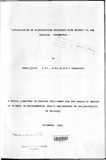| dc.description.abstract | Conventional water treatment usually include coagulationflocculation
processes. Flocculation is influenced by several
factors, both physical and chemical. The study presents: short notes
on coagulation - flocculation theory, principles, and practice; a
brief review of literature on the physical aspects of flocculation
with special reference to flocculation kinetics. A rational approach
for optimizing the physical parameters of flocculation is presented.
The optimum combination of velocity gradient, G, and time of
mixing,T, has been suggested for raw water turbidities and
temperatures normally encountered in water and their possible
applications in process design and control discussed.
At a given temperature, the optimum G value, Gopt' and the optimum
power function, Gopt.Topt, have linear relationships with the
logarithm of the raw water turbidity value. There is also a linear
relationship between the logarithms of Gopt and Topt at all
temperatures and turbidity values. For a given turbidity, optimum
G and T values are higher at lower temperatures while for a given
temperature the optimum values are higher at lower turbidity
values. | en |

